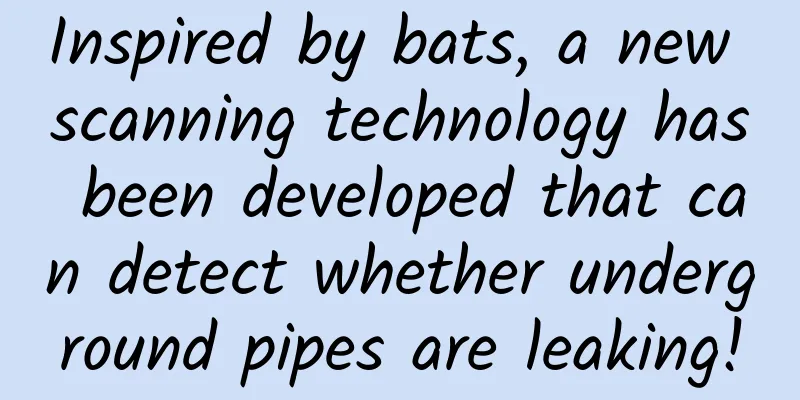Inspired by bats, a new scanning technology has been developed that can detect whether underground pipes are leaking!

|
Engineers have developed a new scanning technology inspired by nature that can detect corroded metal in oil and gas pipelines. By mimicking how bats use different wavelengths of ultrasound to detect objects, hunt and avoid predators, engineers have developed a new system that combines two different types of radiation, fast neutrons and gamma rays, to detect corrosion - the leading cause of pipeline leaks. With thousands of kilometers of pipelines used around the world to transport oil and gas over long distances, leaks are a major problem that costs millions of dollars each year. And it has the potential to cause accidents and loss of life, as well as significant environmental damage. Typically, corrosion in oil pipelines is measured using ultrasonic or electromagnetic techniques. However, these methods do not work for underground pipes or pipes covered with concrete or plastic insulation. The new system, developed by engineers at Lancaster University, the National Physical Laboratory and a company called Hybrid Instruments Ltd, exploits the reflected signal known as backscatter, which is an "isolated combination of fast neutrons and gamma radiation" because neutrons and gamma rays have useful complementary properties, and neutrons mainly interact with low-density materials such as plastics. In addition, fast neutrons have a higher penetrating power, making them suitable for probing thick materials. Gamma rays interact mainly with metals and are not always able to penetrate very thick materials with a high density. The two radiation types produce different electronic signatures, which means that the researchers can retain data from both radiation types simultaneously using a new type of detection device called a 'hybrid field analyser', which was previously developed by Lancaster University and Hybrid Instruments Ltd. The system produces a pencil-like beam of probing radiation, consisting of neutrons and gamma rays, which is pointed at the section of steel being inspected. The team tested the real-time imaging technique in the lab on samples of carbon steel of varying thicknesses. The researchers were able to see differences in the thickness of the steel, and the sensor also worked when the insulation was replicated with concrete or plastic, suggesting that defects in the steel as well as corrosion and rust could create variations in backscatter. These results suggest that if used on real pipelines, potential problems could be more easily spotted and fixed before oil and gas are able to leak out. Mauro Licata, a PhD researcher at Lancaster University who worked on the project, said: The combined beams of neutrons and gamma rays bounce in parallel onto an array of detectors, producing a comprehensive and rapid representation of the steel's internal structure. The system works a bit like the ultrasound waves emitted by a bat. These are a superposition of different ultrasound wavelengths that bounce back into the bat's ears. As well as highlighting the benefits of combining multiple reflectance sensing techniques to detect problems such as corrosion, the research further demonstrates that there is huge potential in taking inspiration from and imitating systems that have evolved in nature. Professor Malcolm Joyce of Lancaster University and Hybrid Instruments Ltd said: Real-time isolation of backscattered neutrons and gamma rays from the steel surface, in the same way a bat's brain isolates backscattered ultrasound waves so they are not confused with their own, could help us isolate defects in pipe walls more quickly and efficiently. Neil Roberts, of the National Physical Laboratory, said: "This is a great example of NPL's world-leading neutron facilities being used to innovate science and have a positive impact. The aim is to further develop and use the detector system to detect faults by pointing it at sections of pipe from the outside. However, the researchers said more research is needed in the field of neutron detectors to make the system even faster. Bokeyuan|www.bokeyuan.net Bo Ke Yuan | Research/From: Lancaster University Reference journal: Scientific Reports DOI: 10.1038/s41598-020-58122 BoKeYuan|Science, technology, research, popular science Follow [Bokeyuan] to see more beautiful cosmic science |
Recommend
What is the difference between cinnamon and cassia?
Cinnamon and cassia bark are very common in daily...
What foods are incompatible with red ginseng?
Red ginseng is a common Chinese medicinal materia...
The efficacy and function of cattail
When it comes to stinking cattail, many people ma...
Spending the Winter Solstice on Mars? It Did!
The northern hemisphere of Mars, where the Zhuron...
Can Chinese medicine be boiled overnight?
Before decocting, Chinese medicinal materials mus...
Dinosaurs ruled the earth for 170 million years, but they did not evolve into higher intelligent creatures. Why?
Since the Cambrian explosion, the sun and the moo...
What are the functions of Luobu Ma
Luobu Ma is a very rare wild plant. We also call ...
May 4th Youth Day丨100,000 meters of youth! How many meters are you at?
Youth is full of vitality Spreading down and taki...
Which cancers are related to “eating”?
Pay attention, pay attention! The following 8 typ...
How much of your knowledge of psychology is reliable?
Don't trust any single research result at fac...
Do you understand the “blood” of the earth?
Do you understand the “blood” of the earth? Quest...
Beware! A child was buried alive while digging sand on the beach. This seemingly relaxing game may actually be a deadly risk.
Edit: Thanks Digging sand on the beach can defini...
The efficacy and function of Cordyceps sinensis
Cordyceps sinensis is a very common Chinese medic...
The efficacy and function of horn snail shell
Traditional Chinese medicine is very effective in...
Does mugwort have any effect on pregnant women?
Pregnancy is a special period in a woman's li...









